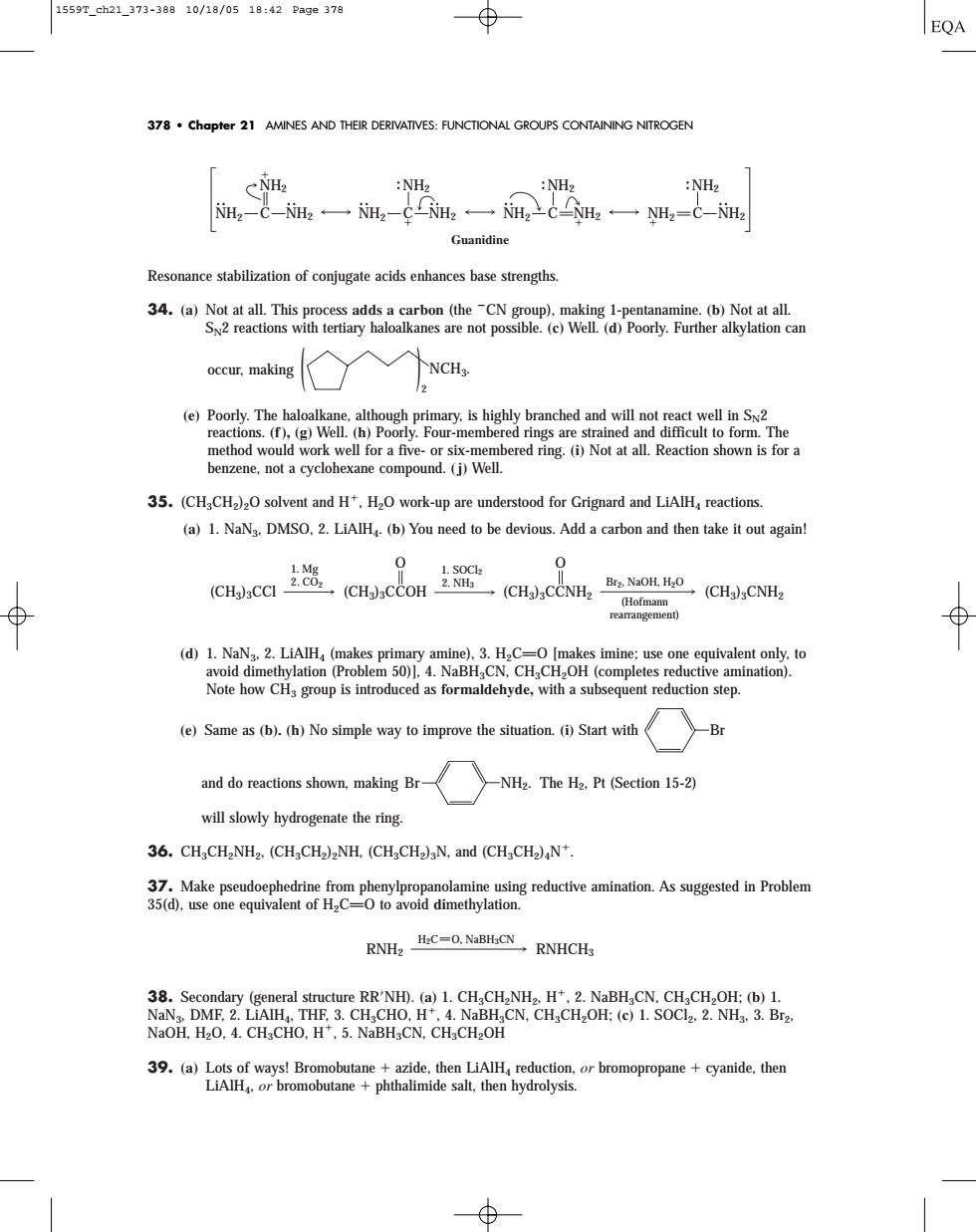正在加载图片...

15597ch21373-38810/18/0518:42Page379 EQA 378.chapter 21 AMINES AND THEIR DERIVATIVES:FUNCTIONAL GROUPS CONTAINING NITROGEN 一性一2一 CNH2 :NH2 Guanidine Resonance stabilization of conjugate acids enhances base strengths anes are not pos benzene,not a cyclohexane compound.(j)Well. 35.(CHCH)2O solvent and H.H2O work-up are understood for Grignard and LiAlH reactions. (a)1.NaN.DMSO.2.LiAH(b)You need to be devious.Add a carbon and then take it out again 0 0 (CH)3CNHz (d) 4.NaBH CN. CH.CH.OH Note owisdormadthi (e Same No dmpke可te0 artwh○一 and do reactions hwa making BHs.The H.P Section 15-2) will slowly hydrogenate the ring. 36.CH,CH,NH2.(CH,CH2)zNH.(CH,CH2)N.and(CH,CH2)4N' RNHC-0NCN RNHCH ture rr'nh) 1CH.CHNH。H+ NaOH,H2O.4.CHsCHO.H'.5.NaBHsCN.CHaCH2OH 9.(a)Lots of ways!Bromobutane+azide then LiAH reduction,rbromopropane+cyanide,then LiAlH.or bromobutane+phthalimide salt,then hydrolysis.Resonance stabilization of conjugate acids enhances base strengths. 34. (a) Not at all. This process adds a carbon (the CN group), making 1-pentanamine. (b) Not at all. SN2 reactions with tertiary haloalkanes are not possible. (c) Well. (d) Poorly. Further alkylation can occur, making (e) Poorly. The haloalkane, although primary, is highly branched and will not react well in SN2 reactions. (f), (g) Well. (h) Poorly. Four-membered rings are strained and difficult to form. The method would work well for a five- or six-membered ring. (i) Not at all. Reaction shown is for a benzene, not a cyclohexane compound. (j) Well. 35. (CH3CH2)2O solvent and H, H2O work-up are understood for Grignard and LiAlH4 reactions. (a) 1. NaN3, DMSO, 2. LiAlH4. (b) You need to be devious. Add a carbon and then take it out again! (d) 1. NaN3, 2. LiAlH4 (makes primary amine), 3. H2CPO [makes imine; use one equivalent only, to avoid dimethylation (Problem 50)], 4. NaBH3CN, CH3CH2OH (completes reductive amination). Note how CH3 group is introduced as formaldehyde, with a subsequent reduction step. (e) Same as (b). (h) No simple way to improve the situation. (i) Start with and do reactions shown, making The H2, Pt (Section 15-2) will slowly hydrogenate the ring. 36. CH3CH2NH2, (CH3CH2)2NH, (CH3CH2)3N, and (CH3CH2)4N. 37. Make pseudoephedrine from phenylpropanolamine using reductive amination. As suggested in Problem 35(d), use one equivalent of H2CPO to avoid dimethylation. 38. Secondary (general structure RRNH). (a) 1. CH3CH2NH2, H, 2. NaBH3CN, CH3CH2OH; (b) 1. NaN3, DMF, 2. LiAlH4, THF, 3. CH3CHO, H, 4. NaBH3CN, CH3CH2OH; (c) 1. SOCl2, 2. NH3, 3. Br2, NaOH, H2O, 4. CH3CHO, H, 5. NaBH3CN, CH3CH2OH 39. (a) Lots of ways! Bromobutane azide, then LiAlH4 reduction, or bromopropane cyanide, then LiAlH4, or bromobutane phthalimide salt, then hydrolysis. H2C O, NaBH3CN RNH2 RNHCH3 Br NH2. Br 1. Mg 2. CO2 1. SOCl2 2. NH3 (CH3)3CCl (CH3)3CCOH O Br2, NaOH, H2O (Hofmann rearrangement) (CH3)3CCNH2 (CH3)3CNH2 O ( ( NCH3. 2 NH2 C NH2 NH2 NH2 C NH2 NH2 NH2 C NH2 NH2 NH2 C NH2 NH2 Guanidine 378 • Chapter 21 AMINES AND THEIR DERIVATIVES: FUNCTIONAL GROUPS CONTAINING NITROGEN 1559T_ch21_373-388 10/18/05 18:42 Page 378